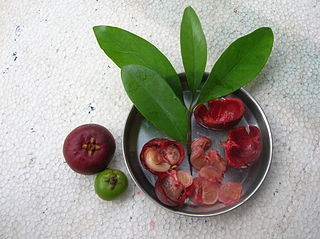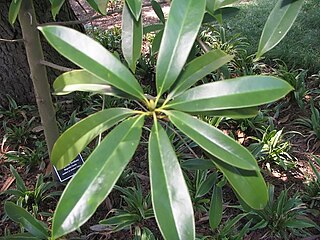
Quercus palustris, also called pin oak, swamp oak, or Spanish oak, is a tree in the red oak section of the genus Quercus. Pin oak is one of the most commonly used landscaping oaks in its native range due to its ease of transplant, relatively fast growth, and pollution tolerance.

Mangosteen, also known as the purple mangosteen, is a tropical evergreen tree with edible fruit native to tropical lands surrounding the Indian Ocean. Its origin is uncertain due to widespread prehistoric cultivation. It grows mainly in Southeast Asia, southwest India and other tropical areas such as Colombia and Puerto Rico, where the tree has been introduced.

Garcinia is a genus of flowering plants in the family Clusiaceae native to Asia, America, Australia, tropical and southern Africa, and Polynesia. The number of species is disputed; Plants of the World Online (POWO) recognise up to 400. Commonly, the plants in this genus are called saptrees, mangosteens, or garcinias, and is one of several plants known as by the name "monkey fruit".

Gardenia mannii, the nānū, Oahu gardenia or Mann's gardenia, is a species of flowering tree in the coffee family, Rubiaceae, that is endemic to the island of Oʻahu in Hawaiʻi. It inhabits coastal mesic, mixed mesic, and wet forests at elevations of 100–730 m (330–2,400 ft) in the Koʻolau and Waiʻanae Ranges. It is threatened by habitat loss.

Garcinia dulcis is a tropical fruit tree native to the Philippines, Java, Lesser Sunda Islands, eastern Indonesia, and Papua New Guinea. It was domesticated early and spread inland into mainland Asia. It is commonly known as mundu or munu in Indonesia and Malaysia, baniti or taklang-anak in the Philippines, and maphuut or ma phut in Thailand.

Garcinia indica, a plant in the mangosteen family (Clusiaceae), commonly known as kokum, is a fruit-bearing tree that has culinary, pharmaceutical, and industrial uses. It primarily grows in the Western Ghats, especially the Goa and Konkan region.

Irvingia malayana, also known as wild almond or barking deer’s mango, is a tropical evergreen tree species in the family Irvingiaceae. The specific epithet malayana is from the Latin meaning "of Malaya".
Beilschmiedia gaboonensis is an evergreen tree in the subgenus Hufelandia of the genus Beilschmiedia, in the family Lauraceae. It is native to central Africa. It is a medium-sized tree which can measure up to 30 m tall with a bole diameter of up to 60 cm. It is distributed from southern Nigeria to the Congo basin, occurring in Cameroon, Gabon and Zaïre. It is associated with marshy locations in lowland rainforest. Similarly to Beilschmiedia mannii, it is known under the trade names "kanda" and "pink kanda". The bark is used in analgesic and healing ointments.

Rauvolfia mannii grows as a shrub or small tree up to 8 metres (26 ft) tall. Its fragrant flowers feature white to pink or red-brown, or yellow corolla lobes. Its habitat is forests from sea level to 2,500 metres (8,200 ft) altitude. The plant has been used as arrow poison. Rauvolfia mannii is native to central Africa.

Garcinia warrenii, a is a fruit-bearing tree, up to 15 metres in height, of the mangosteen family (Clusiaceae), commonly known as native mangosteen or Warren's mangosteen. It is found in the tropical rainforests of northern and north-eastern Australia and New Guinea. The genus Garcinia, belonging to the family Clusiaceae, includes about 200 species found in the Old World tropics, mostly in Asia and Africa. Garcinia warrenii is indigenous to New Guinea, the Torres Strait Islands, northeastern Queensland from Cape York Peninsula south to Babinda, and a small, isolated population on Melville Island in the Northern Territory, Australia.
Garcinia binucao is a species of flowering plant in the Clusiaceae family. It is commonly known as binukaw or batuan, is a species of Garcinia endemic to the Philippines. It is not cultivated, though its edible fruits are harvested from the wild for use as a souring agent in some Filipino dishes.

Garcinia sessilis, commonly known as heilala in Tongan, is an evergreen tree native to the Pacific regions of Tonga. The heilala flower is the national flower of Tonga.
Garcinia forbesii, commonly known as the rose kandis or kandis, is a small to medium-sized tree in the family Clusiaceae (Guttiferae). The specific epithet (forbesii) honors Scottish naturalist Henry Ogg Forbes.

Garcinia pseudoguttifera, known as the mo'onia tree in its native range, is a species of flowering tree in the family Clusiaceae (Guttiferae). The specific epithet (pseudoguttifera) comes from Greek pseudo and Neo-Latin guttifera.
Garcinia magnifolia, also known as bebasajo or giant leaf madrono, is a flowering tree in the family Clusiaceae (Guttiferae). The specific epithet (magnifolia) comes from Latin magni and folia, and refers to the plant's large leaves.
Garcinia leptophylla is an evergreen flowering tree in the family Clusiaceae (Guttiferae). The specific epithet (leptophylla) comes from Greek leptos, and phyllon, and refers to the plant's slender leaves.
Camptostylus is a genus of flowering plants belonging to the family Achariaceae.
Icacina is a genus of flowering plants belonging to the family Icacinaceae.
Heterosamara is a genus of flowering plants belonging to the family Polygalaceae.

Magnolia fordiana is a widespread species of flowering plant in the family Magnoliaceae, native to southern China, Hainan, and Vietnam. An evergreen tree reaching 25 m (82 ft) tall, it is found in hilly forests, often beside rivers, at elevations from 300 to 1,200 m. Specialists in Magnolia believe that most Magnolia fordiana specimens offered for sale are actually the closely related Magnolia yuyuanensis, a more attractive tree and one that is better adapted to cultivation. It is widely used as a street tree in southern Chinese cities.














